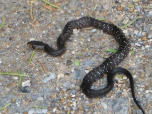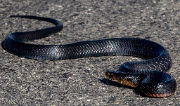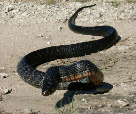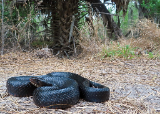Central American Indigo (Drymarchon melanurus)
Description: D. melanurus is a large species that can grow to a total length (including tail) of 6 feet to over 8 feet. This species has predominantly olive-brown glossy dorsal scales evolving to black at the tail. The underside is a lighter olive-yellow, olive-tan color. D. melanurus has distinctive dark markings round the eyes, a vertical dark slash just behind the jaw. and a heavy diagonal dark slash on both sides of the neck.
The subspecies D. m. erebennus is predominantly solid black, though there can be lighter shaded variations.
Habitat: In the northern part of its distribution it occupies a variety of habitats including savannas, mangroves, thorn forests, and taller wetter forests. In the southern part of the range, habitat includes tropical and subtropical wet, moist, and dry forests (including secondary growth and often near water), edges of forest clearings, riparian zones through open areas, savannas, and mangroves. This is a primarily terrestrial snake that often uses burrows. Diurnal and crepuscular species.
Range: Only the subspecies D. m. erebennus is found in southern Texas and southwards into Mexico as far as Veracruz.
Found in these States:
TX
Diet: Eats small mammals, birds, frogs, lizards, snakes, and other vertebrates of appropriate size.
Reproduction: Eggs may be laid in gopher (Geomys) burrows or similar sites.
Status: The species has declined in distribution and abundance at the northern end of the range in Texas, but it remains locally common there in some areas . Listed as Least Concern because of its extremely wide distribution, presumed large population, occurrence in multiple protected areas, and because it is unlikely to be declining fast enough to qualify for any of the threatened categories.
Subspecies: Five with just one found in our Region:
Texas Indigo Snake - (Drymarchon melanurus erebennus)
Black-tailed Indigo Snake - (Drymarchon melanurus melanurus)
Orizaba Indigo Snake - (Drymarchon melanurus orizabensis)
Mexican West Coast Indigo Snake - (Drymarchon melanurus rubidus)
Unicolor Indigo Snake - (Drymarchon melanurus unicolor)
»» Kingdom: Animalia - Animals
»» Phylum: Chordata - Chordates
»» Subphylum: Vertebrata - Vertebrates
»» Class: Reptilia - Reptiles
»» Order: Squamata - Scaled Reptiles
»» Suborder: Serpentes
»» Superfamily: Colubroidea
»» Family: Colubridae - Colubrids
»» Genus: Drymarchon
»» Species: Drymarchon melanurus - Central American Indigo
»» Subspecies:
»» Drymarchon melanurus erebennus - Texas Indigo Snake »» Drymarchon melanurus melanurus - Black-tailed Indigo Snake »» Drymarchon melanurus orizabensis - Orizaba Indigo Snake »» Drymarchon melanurus rubidus - Mexican West Coast Indigo Snake »» Drymarchon melanurus unicolor - Unicolor Indigo Snake
This article uses material from the Wikipedia article "Middle American indigo snake", which is released under the Creative Commons Attribution-Share-Alike License 3.0. Content may have been omitted from the original, but no content has been changed or extended.
|








